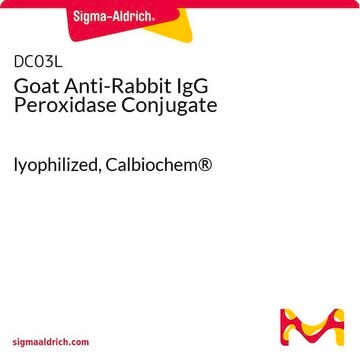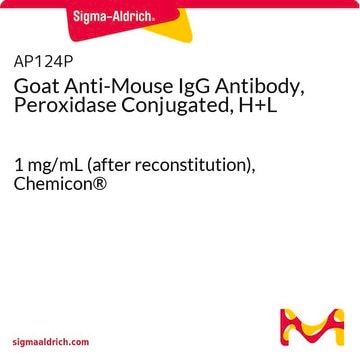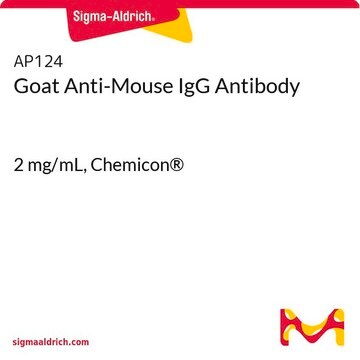DC02L
Goat Anti-Mouse IgG Peroxidase Conjugate
lyophilized, Calbiochem®
Sign Into View Organizational & Contract Pricing
All Photos(1)
About This Item
UNSPSC Code:
12352203
NACRES:
NA.41
Recommended Products
biological source
goat
Quality Level
antibody form
affinity isolated antibody
antibody product type
secondary antibodies
clone
polyclonal
form
lyophilized
does not contain
preservative
manufacturer/tradename
Calbiochem®
storage condition
OK to freeze
isotype
IgG
shipped in
ambient
storage temp.
2-8°C
target post-translational modification
unmodified
General description
Immunoaffinity purified goat polyclonal antibody adsorbed against human, bovine, and horse serum proteins and conjugated to horseradish peroxidase. Recognizes mouse IgG.
This Goat Anti-Mouse IgG Peroxidase Conjugate is validated for use in ELISA, Immunoblotting, Immunohistochemistry for the detection of Mouse IgG.
Immunogen
Mouse
Application
ELISA (1:5000-1:100,000)
Immunoblotting (1:5000-1:100,000, colorimetric; 1:10,000-1:200,000, chemiluminescence)
Immunohistochemistry (1:500-1:5000)
Immunoblotting (1:5000-1:100,000, colorimetric; 1:10,000-1:200,000, chemiluminescence)
Immunohistochemistry (1:500-1:5000)
Warning
Toxicity: Standard Handling (A)
Physical form
Lyophilized from 250 mM NaCl, 10 mM sodium phosphate, 15 mg/ml BSA, pH 7.6.
Reconstitution
Reconstitute the antibody with 1.5 ml H₂O. Dissolve by gently mixing at 4°C, since extensive mixing will denature antibodies. Following reconstitution, aliquot and freeze (-70°C). Avoid freeze/thaw cycles of solutions. Alternatively, glycerol (to a final concentration of 50%) may be added and the reconstituted antibody then stored at -20°C. Please note, under these conditions the concentration of the antibody and the buffer salts will be one-half of the original concentration.
Other Notes
To ensure the quality of these reagents each lot is tested with several of our primary antibodies. Antibody specificity is tested by immunoelectrophoresis and shown to be specific for mouse IgG but not with light chains common to most mouse immunoglobulins. No cross-reactivity with non-immunoglobulin serum proteins has been detected. The antibody has also been tested by ELISA and/or adsorbed to ensure minimal cross-reactivity with human, bovine, and horse serum proteins, but the antibody may exhibit cross-reactivity with immunoglobulins from other species. Antibody should be titrated for optimal results in individual systems.
Legal Information
CALBIOCHEM is a registered trademark of Merck KGaA, Darmstadt, Germany
Not finding the right product?
Try our Product Selector Tool.
Storage Class Code
11 - Combustible Solids
WGK
WGK 3
Certificates of Analysis (COA)
Search for Certificates of Analysis (COA) by entering the products Lot/Batch Number. Lot and Batch Numbers can be found on a product’s label following the words ‘Lot’ or ‘Batch’.
Already Own This Product?
Find documentation for the products that you have recently purchased in the Document Library.
Jing-Qiang Huang et al.
Journal of translational medicine, 17(1), 143-143 (2019-05-08)
The distant metastasis of cancer cells is a risk factor for tumor lethality and poor prognosis in non-small-cell lung carcinoma (NSCLC). Increased SOX9 expression has been associated with clinical stage and poor prognosis in NSCLC, but the molecular mechanisms by
Timothy C Cox et al.
Human mutation, 40(10), 1813-1825 (2019-06-20)
Cleft lip with or without cleft palate (CL/P) is generally viewed as a complex trait with multiple genetic and environmental contributions. In 70% of cases, CL/P presents as an isolated feature and/or deemed nonsyndromic. In the remaining 30%, CL/P is
Rhian Jones et al.
Nature, 589(7843), 615-619 (2020-12-18)
Positive-sense single-stranded RNA viruses, such as coronaviruses, flaviviruses and alphaviruses, carry out transcription and replication inside virus-induced membranous organelles within host cells1-7. The remodelling of the host-cell membranes for the formation of these organelles is coupled to the membrane association
R Tremmel et al.
The pharmacogenomics journal, 16(6), 551-558 (2015-10-28)
Gene copy number variants (CNVs) of CYP2E1 have been described but not functionally characterized. Here we investigated effects of CNVs on hepatic and lymphoblastoid CYP2E1 expression. Using available single-nuleotide polymorphism microarray data and quantitative PCR, CYP2E1 gene duplication and deletion
Erich J Goebel et al.
eLife, 11 (2022-06-24)
Activin ligands are formed from two disulfide-linked inhibin β (Inhβ) subunit chains. They exist as homodimeric proteins, as in the case of activin A (ActA; InhβA/InhβA) or activin C (ActC; InhβC/InhβC), or as heterodimers, as with activin AC (ActAC; InhβA:InhβC).
Our team of scientists has experience in all areas of research including Life Science, Material Science, Chemical Synthesis, Chromatography, Analytical and many others.
Contact Technical Service





